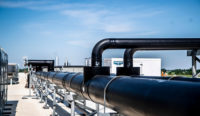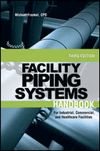Featuring a corporate history dating to the early 20th century and cutting-edge technology such as the Crest® Condensing Boiler, Lochinvar® Corporation is a leading manufacturer of high-efficiency water heaters, boilers, pool heaters, and storage tanks.
Lochinvar performs a 100% functional test on every water heater and boiler produced in their Lebanon, TN, facility, requiring a specific amount of water flow during these tests. The company’s life-cycle testing and product development department has experienced a continual increase in demand for gpm in its hydronic testing loop.
A new system designed to satisfy the requirements for testing water heaters, boilers, and pool heaters was needed in the winter of 2011 to serve the manufacturing facility. So when the company’s facilities group was in the process of designing the new testing facility, an innovative pressure pipe system was met with curiosity and a bit of skepticism.
AN INTRIGUING ALTERNATIVE
Lee Company, a leading provider of HVAC, plumbing, and electrical solutions with headquarters in Franklin, TN, has worked with Lochinvar for roughly 15 years. Lee Company sales engineer, Kenny England, explained that due to the potential of long term degradation of steel piping at the facility, Aquatherm Inc.’s polypropylene-random (PP-R) pipe seemed like a good alternative for the new loop.
“Aquatherm had so many benefits for this application that it was very easy to spell them out,” explained Rick Hollis, salesman with the Nashville office of Ferguson Enterprises, Inc. (a Lochinvar distributor). Aquatherm’s Climatherm® is specifically designed for HVAC applications, and with the company’s faser composite layer, it provides exceptional strength and resistance to thermal expansion — by up to 75% compared to plastic piping — in operating temperatures up to 200°F.
Corrosion-resistant and featuring a natural R-value of 1, Aquatherm is connected via heat fusion, which bonds both sides of a joint into a single, homogenous material, without the use of flames, chemicals, or mechanical connections. Once fused, pipes and fittings have the same physical properties, thus eliminating systematic weaknesses.
“Along the way we decided that Climatherm® piping would be a better long-term product, as there are no long-term corrosion or degradation issues,” said Lochinvar facility manager Jim Durbin. “Also, Climatherm did not require insulating the piping like we would have had to with black pipe.”
England said Aquatherm’s extensive warranty also helped sway Lochinvar. When installed by Aquatherm-trained and certified technicians, the pipe and fittings carry a 10-year, multimillion-dollar warranty covering product liability, personal injury, and property damage.
A STEEP — BUT WORTHWHILE — LEARNING CURVE
Ferguson and Aquatherm conducted a fusion welding training session for several installers and Lee Company rented fusion welding tools from Ferguson. A majority of the work was done at the pre-fab shop, where flanges were welded to 40-ft sections of the 8-in. pipe. Several workers installed roughly 1,300 ft of 8-in. Climatherm and 200 to 300 ft each of 3- and 4-in. Climatherm.
The installation began in February 2011 and took roughly 45 days. While the Lee installers experienced a learning curve, they got quicker as they became comfortable with the fusion tools and the PP-R.
Main and branch lines run from the heat rejection/heat recovery loop of the building to the test area, where each water heater, boiler, or pool heater is filled with water and tested, simulating a real world installation, before it is shipped. The water is heated, flushed, and re-used.
The system rejects heat from eight test stations and delivers up to 1,250 gpm of 95ºF heat rejection water (± 2º) to each test area. The system also cools the 120º heat rejection water to 95º for re-use.
While the material for the Aquatherm pipe was slightly more expensive than the Schedule 40 steel, the ability to install in 40-ft sections instead of 20-ft sections, and use only three men to hang the pipe was huge, England said. “We were installing this pipe 20 ft in the air, and the lighter weight of the Aquatherm was a big labor savings,” he added.
MORE FUSION IN THE WORKS
“When you get familiar with Aquatherm, you can pick up a lot of labor savings, but the learning curve did cost me some of that profit on this job. Money-wise Aquatherm cost me a bit more, but the customer is really happy with it, and at end of day that’s what’s important,” England said. “Plus, their flow rate to their test area is a lot better than it was with the steel pipe.”
Architectural firm breathes new life into old facility with low-speed fans
For builders, it’s often more economical to tear down a structure than invest resources into repurposing it. With a number of old box stores, shopping centers, and strip malls sitting vacant county-wide, it’s impressive to learn about one such abandoned facility whose fate was revived. Once an auto repair shop that sat vacant for a quarter century, the 30,000-sq-ft new home of Rice Fergus Miller (RFM) architects in Bremerton, WA, sits atop a one-level parking garage and feels like “a cross between a warehouse, a nightclub, and an office,” said Steve Rice, partner, architect, and LEEP® AP.
As a growing and contemporary architecture and design firm, RFM took the opportunity to test its own energy-efficiency theories when conceptualizing the new office space. R-30 walls and an R-50 roof as well as windows with a U-factor of 0.25 were all employed in the building envelope. Large-diameter, low-speed fans and a variable-speed double heat pump system replaced the need to run ductwork through the building.
Taking advantage of the year-round mild climate, RFM created a workplace that’s four times as efficient as a benchmark building in Seattle. However, converting a “wreck” of a building into a vibrant studio required significant innovation.
FANS AND ENVELOPE WORK IN TANDEM
The extra thick insulated jacket slows down the rate at which the building sheds heat in the winter and gains heat in the summer.
“We’ve added solar on the roof and our energy model now says we should be able to operate at 19 kBtu/sq ft/year,” said Rice. “The average temperature in Seattle is 78° F which gives you some idea of where we are.”
At the heart of the project — a large, three-story alcove — RFM produced a chimney effect by cutting a sizable hole in the floor and instituting a passive ventilation system with clerestory windows. Moderate outdoor temperatures and a thick shell of insulation prevent extreme temperature swings within the space, ensuring thermal comfort for employees and visitors. But when temperatures fall outside of a 15° “passive zone,” the HVAC system provides conditioned air.
To avoid running ducts throughout the space, the designers integrated variable-speed heat pumps in localized places and installed ceiling fans to mix the air. While smaller fans sufficed in the low-ceilinged conference rooms and work pods, a larger fan was needed to mix the air in the main space and provide a heat recirculation and ventilation supplement to the design.
The architects turned to Big Ass Fans and installed a 14-ft diameter, silent Element® fan to provide year-round air circulation. Installed 20-ft up at the studio level, the fan is about 32 ft from the floor and circulates at no more than 50% of its maximum speed. In the summer, Element provides an evaporative cooling effect to ensure thermal comfort, and in the colder months, it redistributes hot air that rises to the top of the three-story alcove. Whether the HVAC system is in active or passive mode, the fan supplements the ventilation system.
“Heating and cooling is one thing, and that happens some of the time, but ventilating happens all the time, and that’s why the fans are always on,” said Rice.
LEED® ACHIEVED
In addition to the energy-efficient Big Ass Fan, solar paneling, and significant R factors, RFM implemented a variety of green building technologies including recycled building materials, rainwater collection, and re-use of an existing structure. Thanks to inventive design strategies and a unique adaptation of existing space, RFM’s Bremerton office received LEED Platinum certification through the USGBC.
Caption:
Low-speed fans helped this architectural firm earn LEED®Platinum certification.
Non-profit goes lean, gets green, earns LEED®Silver
Not-for-profit organizations rarely construct green buildings, but Mercy Neighborhood Ministries of Philadelphia (MNMP) proved careful cost planning can produce a sustainable design that pays dividends for years to come.
Proof is the new 32,000-sq-ft Mercy Family Center, an 85-year-old, former industrial storage warehouse that the MNMP design team retrofitted into a green building showcase with LEED® silver certification.
Led by Sister Ann Provost, MNMP’s executive director, the design team included Philadelphia firms Brawer & Hauptman Architects, consulting engineers Elliott-Lewis, and general contractor The Sullivan Company (Essington, PA).
“We wanted a green building from the beginning, but it was Brawer and Hauptman that introduced us to LEED,” said Sister Ann, who gathered project funding through private donations and conventional bank financing. “Building material choices were chosen according to budget and then sustainability, therefore going green only added about 1% to the budget. This is considerably lower than typical green buildings.”
The building structure, for example, was improved with energy efficient window replacements, skylight refurbishment to allow more natural light, wall/roof insulation, a white reflective roof, and the use of recycled building materials. The renovation was accomplished while still retaining the 1920s character of the building according to the Preservation Alliance of Greater Philadelphia, which recently presented the Mercy Family Center with a “Preservation Achievement Award.”
VENTILATION DESIGN RACKS UP LEED CREDITS
The HVAC systems also accumulated LEED credits to help achieve silver certification. The air distribution system uses Verona™ commercial fabric duct by DuctSox Corp., with “Comfort Flow” air dispersion featuring a linear arrangement of round L-vents, which were designed to provide 25 to 50 cfm/linear foot of airflow. Del-Ren Associates, a Philadelphia-based air distribution manufacturer’s representative, provided design assistance and was the liaison between the fabric duct manufacturer’s custom engineering department and Elliott-Lewis’ sales engineers, Ed Silcox and Nick Simonetti, and The Sullivan Company’s Erik Fay, P.E., senior project manager.
When combined with Comfort Flow’s factory-engineered permeability that allows approximately 15% of the supply air to flow through the fabric itself, the ductwork’s dispersion provides even airflow vs. the hot spots and drafts associated with metal duct/register systems. The evenness also results in less equipment run-time, which saves additional energy. Fabric duct contributes to LEED credits, because it eliminates the need for protective metal duct coatings and the volatile organic compound (VOC) off-gassing associated with them; reduces jobsite waste because of custom manufacturing for the application; increases mechanical equipment efficiencies due to better air dispersion than metal duct; and improves air quality among other factors.
Choosing fabric duct vs. metal duct also contributed to an estimated 10% and 20% savings in materials and labor, respectively, according to Fay. Modern Sheet Metal (Bristol, PA), installed the fabric duct and fabricated the metal plenums and adaptors required in
connecting fabric duct to HVAC equipment.
Cost savings are irrelevant without performance and occupant indoor air comfort, however. “We’ve noticed a significant difference in air comfort with fabric duct vs. metal duct at the Mercy Family Center, which is important with occupants that are elderly or very young,” said Sister Ann.
Aesthetically, the fabric ductwork also looks more streamlined than its metal counterpart. The duct also subliminally segregates the MNMP’s two licensed programs, Child Care and Adult Day, with color coding of blue and tan, respectively. The MNMP round ductwork ranges from 8 to 32-in. dia is hung from an H-Track suspension system and uses a variety of up-flow (2 and 10-o’clock) and down-flow (4 and 8 o’clock) airflow combinations. The children’s arts room is accented with primary red ductwork in a D-Shape that fits snuggly and unobtrusively into the small, narrow room’s ceiling/wall cranny. “We ordered the fabric duct colors we wanted, which made painting metal ducts with coatings unnecessary along with the VOCs associated with them,” said Fay, who specified fabric duct for The Sullivan Company’s own offices recently.
MECHANICAL SYSTEMS PROVIDE HIGH EFFICIENCY
Another HVAC component adding to LEED credits is a Carrier (Syracuse, NY) 48 Series, high-efficiency 50-ton rooftop unit using environmentally-friendly R-410A refrigerant. The system divides the building into 15 zones each controlled by Carrier’s proprietary VAV boxes and CCN BAS control. The entire system contributed to LEED credits. Ruskin (Kansas City) in-duct sound attenuators also contributed to LEED credits.
The design team had considered other alternatives such as multiple rooftops, but the single rooftop unit and VAV boxes were chosen for the ability to shift loads more efficiently while using less tons of air conditioning.
Pittsburgh airport flies high with new energy management system
Situated on a 9,000-acre site located 16 miles west of the city, Pittsburgh International Airport (PIT) accommodates more than eight million travelers each year. PIT offers about 155 non-stop flights per day to 37 destinations, and has been recognized by organizations including JD Power and Associates for its high quality in meeting travelers’ needs. With new routes being added each year and development surrounding the airfield growing, the airport is a major economic engine for southwestern Pennsylvania.
MAJOR EXPANSION
In the late 1980s, the Allegheny County Airport Authority, operator for PIT, recognized the need to expand and update its facilities to accommodate the growing number of domestic and international flights at PIT. The airport’s original terminal, built in 1952, was considered to be one of the most modern and spacious in the country when it first came online, second only in size to JFK in New York. However, despite the addition of an International Wing in 1972, along with several new docks and rotundas through the 1980s to increase the number of gates, the capacity of the original terminal still proved inadequate.
Construction on the new Pittsburgh International Airport began in 1990, designed to offer 7.7 million sq ft of air-side space, more than 100 gates, and a mall of more than 100 restaurants and specialty shops. Based on the company’s four-decade relationship with the airport, PIT and its architectural consultants tapped Honeywell to supply HVAC and fire alarm systems throughout the new space.
SYSTEMS INTEGRATION
With heightened security concerns following September 11, PIT officials wanted the ability to monitor and control all building systems from its Emergency Operations Center (EOC). The vision was that EOC operators would not only control HVAC and lighting systems through a centralized management platform, but also life safety, security, and other building systems to provide the safest and most comfortable environment for travelers and airport personnel.
The airport implemented Honeywell’s enterprise management system, Enterprise Buildings Integrator (EBI), to help increase efficiency and reduce operating costs by integrating core building technology. The platform tied nearly all building systems into a flexible, open architecture while keeping existing control equipment in place.
The integrated platform has proven beneficial for PIT throughout its tenure. Most notably, EBI demonstrated its power during a smoke test conducted by PIT and its fire department not long after its installation. Airport officials wanted to verify how smoke would travel throughout a particular area of the terminal in the event of a fire. To test smoke control capabilities — involving the combined use of fire alarm and HVAC systems — the fire department set up artificial smoke machines to simulate a blaze in one of the retail stores located along the concourse. During the test, when the alarm system detected smoke, the HVAC system immediately kicked in, ventilating the area exactly as planned.
In addition to HVAC and fire, PIT has integrated other systems into its platform, including a defibrillator system. If someone in the airport has a heart attack or other medical emergency that necessitates the use of a defibrillator unit, the removal of the unit automatically notifies EOC operators through an alarm, indicating the exact location of the incident and helping emergency responders take action as quickly and effectively as possible.
PIT also has linked its fire system into all off-site buildings, including hangars, fuel farms, maintenance garages, parking garages and rental car buildings, and is exploring ways to tie in data from its closed circuit television (CCTV) system, as well as the airport’s Flight Information Display System (FIDS) — the network of screens across the airport detailing flight arrival and departure times.
ENERGY CONSERVATION
With the reduced number of flights and travelers after September 11, as well as the continual rise in fuel costs, the airport also recognized the need to gain better control of its energy use across its facilities to help offset these pressures. In response, PIT established an energy management team made up of airport management, facilities personnel, and Honeywell consultants that meet on a monthly basis to assess energy conservation opportunities throughout the airport.
For example, the rooftop units that heat and cool the airport have been optimized to minimize electrical consumption, escalators and moving walkways are shut down at night when traffic is relatively low, and occupancy sensors have been placed throughout areas of the terminal to minimize lighting use, particularly at night. With Honeywell’s guidance, PIT also is exploring submetering across the terminal to better understand and regulate energy use with tenant organizations, such as retail outlets.
By integrating its BAS, PIT has seen both an increase in efficiency and a decrease in operating costs while giving itself the ability to assess and respond to energy conservation opportunities throughout the airport.
With Ryder Cup coming, Minnesota golf club beats par with hot water
retrofit
If you get cranky without a hot shower, imagine the collective frustration of 1,400 dues-paying members — not to mention one-hundred or more PGA Tour golfers and support staff — at one of the most prestigious golf clubs in the nation.
Steeped deep in tradition and natural beauty, disappointment of this magnitude has no place at Hazeltine National Golf Club, which has hosted more United States Golf Association (USGA) events than any other golf club in the United States.
In fact, satisfying members of the private golf club in Chaska, MN, was the primary objective for manager Matt Murphy, charged with overseeing an extensive $15 million, 20-month course and facilities renovation, recently completed in preparation for the 2016 Ryder Cup tournament.
That is why every project detail was measured against its impact on members and their guests, including the hot water delivery system for its 50,000-squ-ft clubhouse, which was leveled and rebuilt as part of the renovation project in 2010.
DEMAND CRITICAL APPLICATIONS
“Without a reliable supply of hot water, our club simply cannot function,” explains Murphy, who has managed club operations since 2007. “From our kitchen and culinary staff, to guest services and locker rooms, down to our onsite laundry facility — dependable hot water is critical.” He adds that the club hosts more than 150 events and draws upwards of 60,000 members and guests each year.
Murphy worked with Dakota Mechanical, a St. Paul, MN-based, full-service mechanical contractor specializing in design/build construction, on the design of the commercial hot water system planned for the new clubhouse. The system needed to support Hazeltine’s diverse demand, including 34 lavatories, 16 kitchen fixtures, 13 shower stalls, along with therapeutic foot baths, and an onsite laundry facility. Dakota began by validating the original specifications for the new clubhouse that called for two 130-gal, 400,000 Btuh water heaters and a 200-gal storage tank.
“Knowing the prominence of the club and the members’ desire for an energy efficient solution, we wanted to flesh out three categories: 1) the planned system recovery rate; 2) the cost to heat and store 460 gallons; and 3) the system reliability,” recalls Brad Glynn Dakota’s service manager, who turned for counsel to independent manufacturer agent NCS Corporation, which represents Rheem Water Heating in Minnesota.
UNCONVENTIONAL, HIGHER EFFICIENCY OPTION
“When examining water heater sizing and storage requirements for the new clubhouse, we determined that a less conventional but higher efficiency option could deliver the same volume of hot water, eliminate the storage tank, circulating pump, and controls, while at the same time making the system more reliable,” explains Rick Matzen, principal with NCS Corporation.
The infrequent, but super-high volume demands of the prestigious club — usually surrounding a special event, peak dinner rush or a professional golf tournament — led Matzen to recommend the Rheem-Ruud SPIDERfire®, a new line of condensing-type commercial water heaters that offer ultra-high performance and up to 95% thermal efficiency rates.
“The SPIDERfire provides outstanding hot water output with dramatic savings on operating costs compared to units with standard 80% efficiency,” reports Matzen, a 33-year plumbing, heating, and cooling industry veteran. “A patented multi-leg heat transfer system channels hot combustion gases through a series of connected, elongated vertical tubes immersed in the water tank that are designed to maximize the exchange of heat energy.” He adds that the vertical tube “legs” are the source of the unit’s unique design and colorful name.
In reviewing the original specification, Matzen and Dakota’s Glynn recommended eliminating the proposed storage tank and replacing the two commercial hot water units with three 100-gal, 300,000 Btuh units, each capable of delivering 408 gal of water per hour at 100°F rise.
The use of the three 93%-efficiency units — installed in a parallel fashion — have a recovery rate of more than 1,000 gal/hr, enabling Dakota to meet spikes in demand without relying on a space-hogging storage tank.
“For projects involving a large variance in use, we tend to use an electronic manifold to control the sequencing of unit operation, thereby extending the lifespan of each hot water heater,” notes Glynn. “By alternating usage among the three units, the system will not overburden any one heater. Also, this type of daisy-chain design typically saves space and energy when compared with high-Btu commercial water heaters that must maintain large hot water reserves 24/7/365.”
BUILT-IN REDUNDANCY
In addition to meeting the club’s diverse and unpredictable demand for hot water, another advantage to the three-unit design is that it significantly increased the system’s redundancy and therefore its dependability.
“A failure in one water heater in a two-unit configuration would cut capacity in half, which could be a problem on busy summer days when a tournament is underway and many people are taking long, hot showers,” said Glynn. “With three heaters, there is a larger safeguard against failure, as two units could probably handle the lion’s share of the club’s hot water needs.
A final benefit of the proposed design was that it utilized a smaller footprint than the original specification.
“As with any mechanical room, real estate space is at a premium. Not only did we eliminate the storage tank, but the SPIDERfire’s slim 26¼-in. diameter was 21% smaller than the original unit specified,” states Glynn, who noted that another advantage was the Rheem unit’s flexible venting options. “To maximize the architectural/aesthetic value of this installation, we were able to use PVC to vent horizontally and position the air intake and exhaust terminations where they were obscured from public view — something that would not be possible with a straight vertical run.”
Matzen and Kurt King of Minneapolis-based wholesaler Water Heaters Only were on hand during the installation of the new system. Both were impressed with the flexibility and performance of the new condensing commercial units.
“Ultra-high efficiency hot water heaters are one of the fastest growing segments of the commercial PHCC market,” reports Matzen. “These units reduce operating costs and energy consumption without sacrificing performance — a real homerun for end users.”
As for club manager Murphy, he says the new system has exceeded expectations.
“We are very pleased with the outcome of this extensive course and facilities renovation and especially our new clubhouse,” says Murphy. “We’re experiencing a 20%to 30% reduction in energy costs for the new club house, despite a 25% increase in square footage — and with the enormous amount of hot water we use, a portion of these savings must be attributed to our high-efficiency water heating system.” ES










